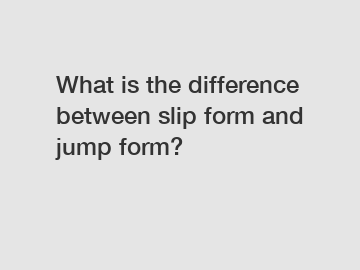Mar. 22, 2024
For more information, please visit Zolo.
If you are looking for more details, kindly visit Zolo.
When it comes to constructing tall buildings and skyscrapers, slip form and jump form are two popular methods used in the industry. These methods are both innovative and efficient in their own ways, but they have distinct differences that set them apart. In this blog post, we will delve into the nuances of slip form and jump form to help you understand their unique characteristics and advantages.

Firstly, let's start by defining slip form. Slip form is a continuous method of construction that involves pouring concrete into a formwork that moves vertically at a steady pace. This allows for the construction of tall structures without having to stop and start the process repeatedly. The formwork is typically made of steel or aluminum and is designed to move smoothly and seamlessly as the concrete sets and hardens. Slip form is ideal for constructing structures that are uniform in shape and size, such as towers and silos.
On the other hand, jump form is a method of construction that involves building a structure in sections or "jumps." The formwork is assembled in sections, and each section is poured with concrete before being moved up to the next level. This process is repeated until the entire structure is completed. Jump form is commonly used for building high-rise structures with varying floor plans and designs, as it allows for flexibility and customization in the construction process.
Featured content:One of the key differences between slip form and jump form is the speed of construction. Slip form is known for its rapid pace, as the continuous pouring and moving of the formwork allows for quick progress in building tall structures. Jump form, on the other hand, may take longer to complete as each section needs to be poured and cured before the next section can be added. However, jump form offers more flexibility in terms of design and floor plan variations, making it a popular choice for complex structures.
Another difference between slip form and jump form is the cost implications. Slip form can be more cost-effective for constructing uniform structures, as the continuous process reduces labor and material costs. Jump form, on the other hand, may be more expensive due to the need for additional formwork and labor to assemble and disassemble the sections. However, jump form can offer savings in terms of design modifications and customization options, as the formwork can be easily adjusted to accommodate changes in the construction plan.
In terms of safety, both slip form and jump form have their own set of risks and challenges. Slip form requires careful planning and coordination to ensure that the formwork moves smoothly and efficiently without any disruptions. Jump form, on the other hand, requires strict adherence to safety protocols and procedures to prevent accidents and mishaps during the construction process. Proper training and supervision are essential for both methods to ensure the safety of workers and the integrity of the structure.
In conclusion, slip form and jump form are two innovative methods of construction that offer unique advantages and challenges. Slip form is ideal for constructing uniform structures quickly and efficiently, while jump form is well-suited for complex structures with varying designs and floor plans. Both methods have their own set of cost implications and safety considerations, so it is important to carefully evaluate your project requirements and constraints before choosing the most suitable method for your construction needs. Whether you opt for slip form or jump form, it is essential to work with experienced professionals who have the expertise and knowledge to ensure a successful and seamless construction process.
You can find more information on our web, so please take a look.
Click here to get more.
Featured content:Related Articles
If you are interested in sending in a Guest Blogger Submission,welcome to write for us!
All Comments ( 0 )